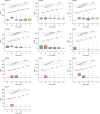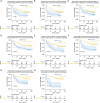Longitudinal assessment of quality of life indicators and prognosis in esophageal cancer patients with curative resection
- PMID: 39444865
- PMCID: PMC11494538
- DOI: 10.21037/jtd-24-311
Longitudinal assessment of quality of life indicators and prognosis in esophageal cancer patients with curative resection
Abstract
Background: The relationship between quality of life and survival outcomes in esophageal cancer patients following curative resection is not well established. This study aimed to longitudinally assess quality of life indicators and their association with overall survival (OS) in these patients.
Methods: A total of 232 patients were included in the study, and their quality of life was prospectively assessed at different time points using the European Organisation for Research and Treatment of Cancer (EORTC) 30-item core quality of life questionnaire (QLQ-C30) and the disease-specific esophageal module (QLQ-OES18). The scores of QLQ indicators at each time point were summarized, and changes in postoperative assessment were compared with preoperative assessments. The association of deterioration in certain indicators with OS was evaluated at each time point using Cox univariable analysis. Further confirmation of independent variables was carried out using Cox multivariable analysis.
Results: The study cohort comprised 62 females (26.7%), and 113 patients (48.7%) aged over 60 years. The median follow-up time was 80 months (range, 8-118 months). At 24 months after discharge, patients reported improvements in role function, fatigue, cognition function, emotional function, social function, insomnia, appetite loss, nausea and vomiting, constipation, financial status, trouble swallowing saliva, and pain related to esophageal cancer. However, physical function, dyspnea, diarrhea, global health status, choking when swallowing, trouble talking, and reflux remained compromised. Multivariable regression analysis revealed deterioration in role function, emotional function, and coughing difficulty at 6 months, and dyspnea, pain, and cognitive function at 24 months post-discharge were identified as independent prognostic factors for OS.
Conclusions: Our findings underscore the importance of monitoring quality of life indicators in esophageal cancer patients as they may significantly influence survival outcomes. The identification of specific quality of life indicators as prognostic factors highlights the need for a patient-centered approach in clinical practice to enhance care and potentially improve survival.
Keywords: Survival analysis; esophageal cancer; patient-reported outcome; quality of life.
2024 AME Publishing Company. All rights reserved.
Conflict of interest statement
Conflicts of Interest: All authors have completed the ICMJE uniform disclosure form (available at https://jtd.amegroups.com/article/view/10.21037/jtd-24-311/coif). The authors have no conflicts of interest to declare.
Figures




References
LinkOut - more resources
Full Text Sources
